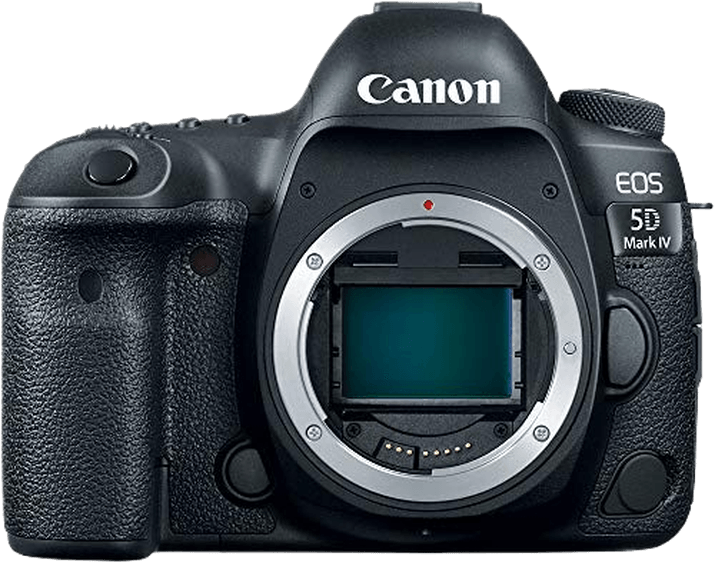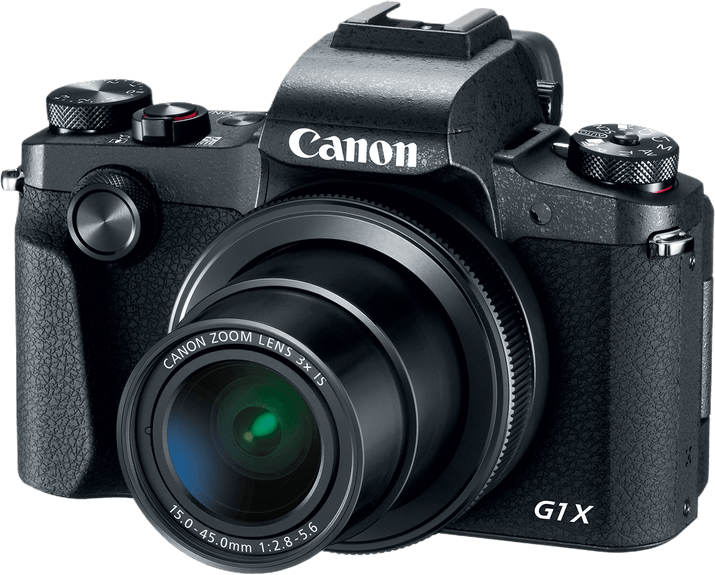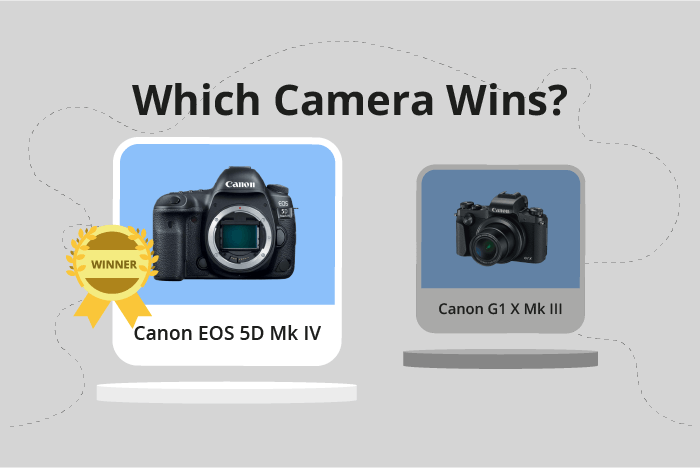Canon EOS 5D Mark IV vs PowerShot G1 X Mark III Comparison
Canon EOS 5D Mark IV

Canon PowerShot G1 X Mark III

The Canon EOS 5D Mark IV outshines the Canon PowerShot G1 X Mark III with a score of 75/100, a 13-point lead over its counterpart’s 62/100. Both cameras were announced in 2016, with the 5D Mark IV being a DSLR and the G1 X Mark III being a bridge camera. They share similar sizes and weights, with the 5D Mark IV measuring 151 x 116 x 76mm and weighing 890g, while the G1 X Mark III measures 138 x 102 x 135mm and weighs 915g.
The 5D Mark IV’s higher score is attributed to its superior performance and features as a DSLR, making it a more versatile and powerful camera for professionals. On the other hand, the G1 X Mark III, as a bridge camera, offers a more compact and affordable option at $1120 compared to the 5D Mark IV’s $3500 price tag.
Considering the specifications and scores, the Canon EOS 5D Mark IV is the better camera for those seeking professional quality and performance, while the Canon PowerShot G1 X Mark III serves as a more budget-friendly and compact alternative for casual photographers.
Canon EOS 5D Mark IV vs PowerShot G1 X Mark III Overview and Optics
The Canon EOS 5D Mark IV outperforms the Canon PowerShot G1 X Mark III in optics, with a score of 76/100 compared to 63/100. Both cameras feature CMOS sensors and have similar processors, with the 5D Mark IV using a Digic 6+ processor and the G1 X Mark III using a Venus Engine processor.
The Canon EOS 5D Mark IV boasts a higher megapixel count at 30.4, as opposed to the G1 X Mark III’s 20 megapixels. This results in more detailed and sharper images. The 5D Mark IV also has a superior DXOMARK sensor score of 91, compared to the G1 X Mark III’s score of 71. This means that the 5D Mark IV has better color depth, dynamic range, and low-light performance. Additionally, the 5D Mark IV has a full-frame sensor, while the G1 X Mark III has a smaller 1″ sensor. This contributes to the 5D Mark IV’s better image quality and low-light performance.
The Canon PowerShot G1 X Mark III has a faster shooting speed of 12 frames per second, compared to the 5D Mark IV’s 7 frames per second. This makes the G1 X Mark III more suitable for capturing fast-moving subjects. The G1 X Mark III also has image stabilization, which the 5D Mark IV lacks. This feature helps reduce camera shake and blur in photos, especially when shooting handheld or in low light conditions.
However, the G1 X Mark III has a fixed lens mount, which limits the user’s ability to change lenses. The 5D Mark IV, on the other hand, has a Canon EF lens mount, allowing for a wide range of lens options and increased versatility.
Taking these factors into account, the Canon EOS 5D Mark IV excels in image quality, sensor performance, and lens versatility, while the Canon PowerShot G1 X Mark III offers faster shooting speed and image stabilization. Depending on the user’s specific needs and preferences, either camera could be a suitable choice.
Canon EOS 5D Mark IV vs PowerShot G1 X Mark III Video Performance
The Canon EOS 5D Mark IV emerges as the winner in terms of video capabilities with a score of 91 out of 100, while the Canon PowerShot G1 X Mark III trails behind with a score of 83. Both cameras share some common specifications, such as 4K maximum video resolution and 4096 x 2160 maximum video dimensions. Additionally, both cameras have built-in time-lapse functionality.
The EOS 5D Mark IV outperforms the G1 X Mark III in several aspects. The most notable advantage is the higher maximum video frame rate of 120fps, compared to the G1 X Mark III’s 60fps. This allows the EOS 5D Mark IV to capture smoother, more detailed slow-motion footage, which is essential for professional videographers and enthusiasts alike.
On the other hand, the G1 X Mark III has its own strengths, but they are not in the video department. The primary advantage of the G1 X Mark III is its compact size and lighter weight, making it more convenient for casual users and travelers who prioritize portability over advanced video features.
Considering the video capabilities of both cameras, the EOS 5D Mark IV is the clear choice for those who prioritize video performance, offering a higher frame rate and overall better video quality. However, the G1 X Mark III may still be an attractive option for users who value portability and are not as concerned with advanced video features. Ultimately, the choice between these two cameras depends on the individual’s priorities and intended usage.
Canon EOS 5D Mark IV vs PowerShot G1 X Mark III Features and Benefits
The Canon EOS 5D Mark IV outperforms the Canon PowerShot G1 X Mark III with a feature score of 74/100 compared to 70/100. Both cameras share some common specifications, such as having a touchscreen, WiFi connectivity, and being part of the Canon brand.
The 5D Mark IV excels in several areas. It has a larger screen size of 3.2 inches, compared to the G1 X Mark III’s 3 inches. Additionally, the 5D Mark IV has a higher screen resolution of 1,620,000 dots, which is significantly more than the G1 X Mark III’s 1,040,000 dots. This results in a clearer and more detailed display. The 5D Mark IV also includes GPS functionality, allowing for geotagging of photos, which the G1 X Mark III lacks.
On the other hand, the G1 X Mark III has some advantages over the 5D Mark IV. It features a flip screen, providing more flexibility for various shooting angles and situations, while the 5D Mark IV does not. Furthermore, the G1 X Mark III includes Bluetooth connectivity, which the 5D Mark IV does not have, offering additional options for transferring and sharing files.
Taking these differences into account, the Canon EOS 5D Mark IV stands out as the better camera in terms of features, with its larger and higher-resolution screen and GPS functionality. However, the Canon PowerShot G1 X Mark III offers some unique features, such as the flip screen and Bluetooth connectivity, which may be appealing to certain users. Ultimately, the choice between these two cameras depends on the individual’s preferences and specific needs.
Canon EOS 5D Mark IV vs PowerShot G1 X Mark III Storage and Battery
The Canon EOS 5D Mark IV outperforms the Canon PowerShot G1 X Mark III in storage and battery with a score of 71/100 compared to 21/100. Both cameras have a single memory card slot and accept SD/SDHC/SDXC (UHS-I compatible) cards. However, the 5D Mark IV additionally supports Compact Flash cards and offers a second memory card slot.
The 5D Mark IV’s battery life is significantly longer at 900 shots, using an LP-E6N battery, whereas the G1 X Mark III only provides 350 shots with its DMW-BLC12 battery. Neither camera supports USB charging. The superior battery life and extra memory card slot make the 5D Mark IV more versatile and reliable for extended shooting sessions.
On the other hand, the G1 X Mark III’s single memory card slot and shorter battery life may be sufficient for casual photographers or those not requiring extended shooting capabilities. It is essential to consider individual needs when comparing storage and battery performance.
Ultimately, the Canon EOS 5D Mark IV is the stronger choice for storage and battery, catering to more demanding photography situations. The Canon PowerShot G1 X Mark III may suffice for more casual usage but falls short of the 5D Mark IV’s capabilities.
Canon EOS 5D Mark IV vs PowerShot G1 X Mark III – Our Verdict
Are you still undecided about which camera is right for you? Have a look at these popular comparisons that feature the Canon EOS 5D Mark IV or the Canon PowerShot G1 X Mark III:

